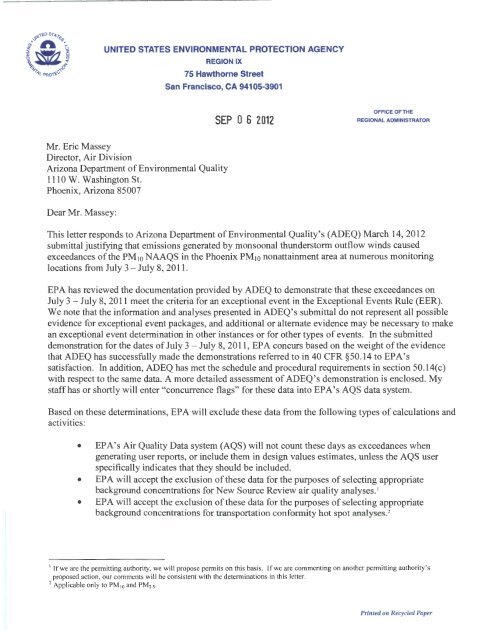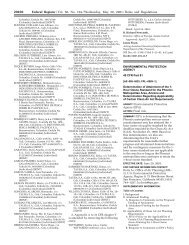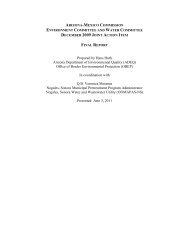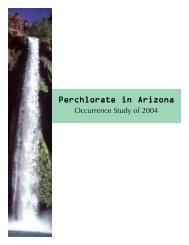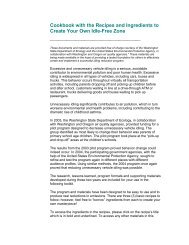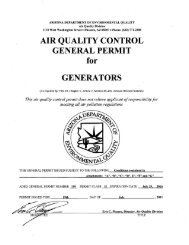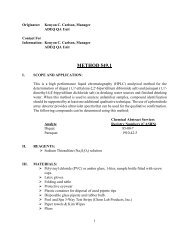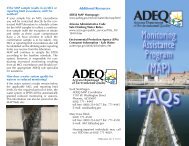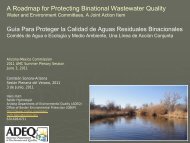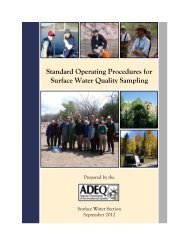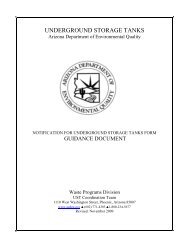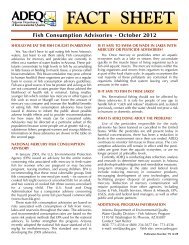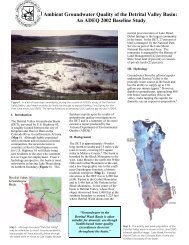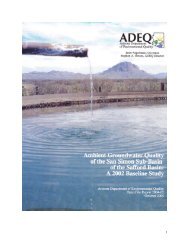U.S. EPA Concurrence Letter for Exceptional Events on July 2
U.S. EPA Concurrence Letter for Exceptional Events on July 2
U.S. EPA Concurrence Letter for Exceptional Events on July 2
You also want an ePaper? Increase the reach of your titles
YUMPU automatically turns print PDFs into web optimized ePapers that Google loves.
UNITED STATES ENVIRONMENTAL PROTECTION AGENCYREGION IX75 Hawthorne StreetSan Francisco, CA 94105-3901SEP 0 6 2012OFFICE OF THEREGIONAL ADMINISTRATORMr. Eric MasseyDirector, Air Divisi<strong>on</strong>Ariz<strong>on</strong>a Department of Envir<strong>on</strong>mental Quality1110 W. Washingt<strong>on</strong> St.Phoenix, Ariz<strong>on</strong>a 85007Dear Mr. Massey:This letter resp<strong>on</strong>ds to Ariz<strong>on</strong>a Department of Envir<strong>on</strong>mental Quality's (ADEQ) March 14, 2012submittal justifying that emissi<strong>on</strong>s generated by m<strong>on</strong>so<strong>on</strong>al thunderstorm outflow winds causedexceedances of the PM 10 NAAQS in the Phoenix PM 10 n<strong>on</strong>attainment area at numerous m<strong>on</strong>itoringlocati<strong>on</strong>s from <strong>July</strong> 3 - <strong>July</strong> 8, 2011.<str<strong>on</strong>g>EPA</str<strong>on</strong>g> has reviewed the documentati<strong>on</strong> provided by ADEQ to dem<strong>on</strong>strate that these exceedances <strong>on</strong><strong>July</strong> 3 - <strong>July</strong> 8, 2011 meet the criteria <str<strong>on</strong>g>for</str<strong>on</strong>g> an excepti<strong>on</strong>al event in the <str<strong>on</strong>g>Excepti<strong>on</strong>al</str<strong>on</strong>g> <str<strong>on</strong>g>Events</str<strong>on</strong>g> Rule (EER).We note that the in<str<strong>on</strong>g>for</str<strong>on</strong>g>mati<strong>on</strong> and analyses presented in ADEQ's submittal do not represent all possibleevidence <str<strong>on</strong>g>for</str<strong>on</strong>g> excepti<strong>on</strong>al event packages, and additi<strong>on</strong>al or alternate evidence may be necessary to makean excepti<strong>on</strong>al event determinati<strong>on</strong> in other instances or <str<strong>on</strong>g>for</str<strong>on</strong>g> other types of events. In the submitteddem<strong>on</strong>strati<strong>on</strong> <str<strong>on</strong>g>for</str<strong>on</strong>g> the dates of <strong>July</strong> 3 - <strong>July</strong> 8, 2011, <str<strong>on</strong>g>EPA</str<strong>on</strong>g> c<strong>on</strong>curs based <strong>on</strong> the weight of the evidencethat ADEQ has successfully made the dem<strong>on</strong>strati<strong>on</strong>s referred to in 40 CFR §50.14 to <str<strong>on</strong>g>EPA</str<strong>on</strong>g>'ssatisfacti<strong>on</strong>. In additi<strong>on</strong>, ADEQ has met the schedule and procedural requirements in secti<strong>on</strong> 50.14( c)with respect to the same data. A more detailed assessment of ADEQ's dem<strong>on</strong>strati<strong>on</strong> is enclosed. Mystaffhas or shortly will enter "c<strong>on</strong>currence flags" <str<strong>on</strong>g>for</str<strong>on</strong>g> these data into <str<strong>on</strong>g>EPA</str<strong>on</strong>g>'s AQS data system.Based <strong>on</strong> these determinati<strong>on</strong>s, <str<strong>on</strong>g>EPA</str<strong>on</strong>g> will exclude these data from the following types of calculati<strong>on</strong>s andactivities:• <str<strong>on</strong>g>EPA</str<strong>on</strong>g>'s Air Quality Data system (AQS) will not count these days as exceedances whengenerating user reports, or include them in design values estimates, unless the AQS userspecifically indicates that they should be included.• <str<strong>on</strong>g>EPA</str<strong>on</strong>g> will accept the exclusi<strong>on</strong> of these data <str<strong>on</strong>g>for</str<strong>on</strong>g> the purposes of selecting appropriatebackground c<strong>on</strong>centrati<strong>on</strong>s <str<strong>on</strong>g>for</str<strong>on</strong>g> New Source Review air quality analyses. 1• <str<strong>on</strong>g>EPA</str<strong>on</strong>g> will accept the exclusi<strong>on</strong> of these data <str<strong>on</strong>g>for</str<strong>on</strong>g> the purposes of selecting appropriatebackground c<strong>on</strong>centrati<strong>on</strong>s <str<strong>on</strong>g>for</str<strong>on</strong>g> transportati<strong>on</strong> c<strong>on</strong><str<strong>on</strong>g>for</str<strong>on</strong>g>mity hot spot analyses. 21If we are the permitting authority, we will propose permits <strong>on</strong> this basis. If we are commenting <strong>on</strong> another permitting authority'sproposed acti<strong>on</strong>, our comments will be c<strong>on</strong>sistent with the determinati<strong>on</strong>s in this letter.2 Applicable <strong>on</strong>ly to PM 10 and PM2.s·Printed <strong>on</strong> Recycled Paper
In additi<strong>on</strong>, <str<strong>on</strong>g>EPA</str<strong>on</strong>g> will rely <strong>on</strong> calculated values that exclude this data in proposed regulatory acti<strong>on</strong>s,such as a proposed designati<strong>on</strong>, classificati<strong>on</strong>, attainment dem<strong>on</strong>strati<strong>on</strong>, or finding as to whether thePhoenix PM10 n<strong>on</strong>attainment area has met the PM10 NAAQS. These regulatory acti<strong>on</strong>s require <str<strong>on</strong>g>EPA</str<strong>on</strong>g> toprovide an opportunity <str<strong>on</strong>g>for</str<strong>on</strong>g> public comment prior to taking a final Agency acti<strong>on</strong>. If <str<strong>on</strong>g>EPA</str<strong>on</strong>g> is pursuing <strong>on</strong>eof these acti<strong>on</strong>s <str<strong>on</strong>g>for</str<strong>on</strong>g> the Phoenix PM 1 o n<strong>on</strong>attainment area, <str<strong>on</strong>g>EPA</str<strong>on</strong>g> will open a new comment period duringwhich <str<strong>on</strong>g>EPA</str<strong>on</strong>g> may receive comments <strong>on</strong> the excepti<strong>on</strong>al event submissi<strong>on</strong> you have made and thedeterminati<strong>on</strong>s c<strong>on</strong>veyed in this letter. If so, we must c<strong>on</strong>sider and resp<strong>on</strong>d to those comments be<str<strong>on</strong>g>for</str<strong>on</strong>g>etaking final regulatory acti<strong>on</strong>. Accordingly, the determinati<strong>on</strong>s c<strong>on</strong>veyed in this letter do not c<strong>on</strong>stitutefinal <str<strong>on</strong>g>EPA</str<strong>on</strong>g> acti<strong>on</strong> regarding any matter <strong>on</strong> which <str<strong>on</strong>g>EPA</str<strong>on</strong>g> is required to provide an opportunity <str<strong>on</strong>g>for</str<strong>on</strong>g> publiccomment. In particular, this applies to determinati<strong>on</strong>s regarding the attainment status or classificati<strong>on</strong> ofthe area. Final acti<strong>on</strong>s will take place <strong>on</strong>ly after <str<strong>on</strong>g>EPA</str<strong>on</strong>g> completes notice and comment rulemaking <strong>on</strong>those determinati<strong>on</strong>s. As an additi<strong>on</strong>al clarificati<strong>on</strong>, the determinati<strong>on</strong>s c<strong>on</strong>veyed in this letter areapplicable <strong>on</strong>ly to determinati<strong>on</strong>s incorporating the submitted data relative to the PM10 NAAQS.If you have any questi<strong>on</strong>s or wish to discuss this matter further, please c<strong>on</strong>tact Deborah Jordan, Directorof the Air Divisi<strong>on</strong> at (415) 947-8715.Sincerely,Enclosurecc:Theresa Rigney, ADEQBryan Paris, ADEQ
EXCEPTIONAL EVENTS RULE REQUIREMENTS<str<strong>on</strong>g>EPA</str<strong>on</strong>g> promulgated the <str<strong>on</strong>g>Excepti<strong>on</strong>al</str<strong>on</strong>g> <str<strong>on</strong>g>Events</str<strong>on</strong>g> Rule in 2007, pursuant to the 2005 amendment of Clean AirAct (CAA) Secti<strong>on</strong> 319. The EER added 40 CFR §50.1(j), (k) and (I); §50.14; and §51.930 to the Codeof Federal Regulati<strong>on</strong>s (CFR). These secti<strong>on</strong>s c<strong>on</strong>tain definiti<strong>on</strong>s, criteria <str<strong>on</strong>g>for</str<strong>on</strong>g> <str<strong>on</strong>g>EPA</str<strong>on</strong>g> approval, proceduralrequirements, and requirements <str<strong>on</strong>g>for</str<strong>on</strong>g> air agency dem<strong>on</strong>strati<strong>on</strong>s, all of which must be met be<str<strong>on</strong>g>for</str<strong>on</strong>g>e <str<strong>on</strong>g>EPA</str<strong>on</strong>g> canc<strong>on</strong>cur under the EER <strong>on</strong> the exclusi<strong>on</strong> of air quality data from regulatory decisi<strong>on</strong>s.Under 40 CFR §50.14(c)(3)(iv), the air agency dem<strong>on</strong>strati<strong>on</strong> to justify exclusi<strong>on</strong> of data must provideevidence that:SUMMARYOverviewA. "The event satisfies the criteria set <str<strong>on</strong>g>for</str<strong>on</strong>g>th in 40 CFR §50.1 (j)" <str<strong>on</strong>g>for</str<strong>on</strong>g> the definiti<strong>on</strong> of anexcepti<strong>on</strong>al event;• The event "affects air quality."• The event "is not reas<strong>on</strong>ably c<strong>on</strong>trollable or preventable."• The event is "caused by human activity that is unlikely to recur at a particularlocati<strong>on</strong> or [is] a natural event." 1B. "There is a clear causal relati<strong>on</strong>ship between the measurement under c<strong>on</strong>siderati<strong>on</strong> and theevent that is claimed to have affected the air quality in the area;"C. "The event is associated with a measured c<strong>on</strong>centrati<strong>on</strong> in excess of normal historicalfluctuati<strong>on</strong>s, including background;" and\D. "There would have been no exceedance or violati<strong>on</strong> but <str<strong>on</strong>g>for</str<strong>on</strong>g> the event."On March 14, 2011, ADEQ submitted excepti<strong>on</strong>al events dem<strong>on</strong>strati<strong>on</strong>s <str<strong>on</strong>g>for</str<strong>on</strong>g> 29 exceeedances of the 24-hour PM 10 standard that occurred at several m<strong>on</strong>itoring stati<strong>on</strong>s within the Phoenix PM 10 n<strong>on</strong>attainmentarea <strong>on</strong> the following days: <strong>July</strong> 3, <strong>July</strong> 4, <strong>July</strong> 5, <strong>July</strong> 7, and <strong>July</strong> 8, 2011. Table 1 summarizes theseexceedances.ADEQ describes the <strong>July</strong> 3rd and 5th events as "large-scale and widespread dust events with mostlysouth-southeasterly winds carryin~ in the dust <strong>on</strong> the 3rd, and southeasterly winds carrying a massivedust wall into the Valley <strong>on</strong> the 5 ,"while the <strong>July</strong> 4th and 7th events ''were smaller in scale, but werestill related to thunderstorm activity and thunderstorm outflow boundary winds." Due to the timing ofthe <strong>July</strong> 7th event, ADEQ explains that, "the impacts in Apache Juncti<strong>on</strong> may have occurred around themidnight hour, leading to the exceedances there being measured <str<strong>on</strong>g>for</str<strong>on</strong>g> <strong>July</strong> gth_, ADEQ provides acomprehensive descripti<strong>on</strong> and discussi<strong>on</strong> of each of these events in Secti<strong>on</strong>s I, II, and V of thedem<strong>on</strong>strati<strong>on</strong>.1A natural event is further described in 40 CFR SO.l(k) as "an event in which human activity plays little or no direct causal role."1
T a bl e 1 <str<strong>on</strong>g>EPA</str<strong>on</strong>g>PM 10 E xcee dan ce s ummaryExceedance Date M<strong>on</strong>itor/Site Name AQSID 24-hour Avg. (pg!m"')<strong>July</strong> 3, 2011 Buckeye 04-013-4011-1 385Central Phoenix 04-013-3002-4 279Durango Complex 04-013-9812-1 277Dysart 04-013-40 I 0-I 239Glendale 04-013-2001-1 242Greenwood 04-013-3010-1 254Higley 04-013-4006-1 196JLG Supersite 04~013-9997-1 227JLG Supersite 04-013-9997-4 228South Phoenix 04-013-4003-1 280West Chandler 04-013-4004-1 198 .West43ro 04-013-4009-1 250West Phoenix 04-013-0019-1 243Zuni Hills 04-013-4016-1 260<strong>July</strong> 4, 2011 Higley 04-013-4006-1 198<strong>July</strong> 5, 2011 Buckeye 04-013-4011-1 163Central Phoenix 04-013-3002-4 277Durango Complex 04-013-9812-1 156D_ysart 04-013-4010-1 219Glendale 04-013-2001-1 167Greenwood 04-013-3010-1 155Higley 04-013-4006-1 362JLG Supersite 04-013-9997-4 331South Phoenix 04-013-4003-1 206West Chandler 04-013-4004-1 360West Phoenix 04-013-0019-1 278<strong>July</strong> 7, 2011 Higley 04-013-4006-1 266West Chandler 04-013-4004-1 214<strong>July</strong> 8, 2011 Apache Juncti<strong>on</strong> 04-021-3002-1 194Not Reas<strong>on</strong>ably C<strong>on</strong>trollable or Preventable (nRCPl<str<strong>on</strong>g>EPA</str<strong>on</strong>g> evaluates whether an event was not reas<strong>on</strong>ably c<strong>on</strong>trollable or preventable at the time ofthe eventby taking into account c<strong>on</strong>trols in place and wind speed, al<strong>on</strong>g with other factors. 2 For natural sources ofdust, a high wind dust event can generally be c<strong>on</strong>sidered to be not reas<strong>on</strong>ably c<strong>on</strong>trollable or preventableif winds are high enough to cause emissi<strong>on</strong>s from natural undisturbed areas. For anthropogenic sourcesof dust, a high wind dust event is also eligible to be c<strong>on</strong>sidered to be not reas<strong>on</strong>ably c<strong>on</strong>trollable orpreventable if:1. The anthropogenic sources of dust have reas<strong>on</strong>able c<strong>on</strong>trols in place,2. The reas<strong>on</strong>able c<strong>on</strong>trols have been effectively implemented and en<str<strong>on</strong>g>for</str<strong>on</strong>g>ced, and3. The wind speed was high enough to overwhelm the reas<strong>on</strong>able c<strong>on</strong>trols.In addressing reas<strong>on</strong>able c<strong>on</strong>trols, ADEQ provided detailed in<str<strong>on</strong>g>for</str<strong>on</strong>g>mati<strong>on</strong> <strong>on</strong> the current set of requiredc<strong>on</strong>trols in the Phoenix PM 10 n<strong>on</strong>attainment area, including in<str<strong>on</strong>g>for</str<strong>on</strong>g>mati<strong>on</strong> <strong>on</strong> rule implementati<strong>on</strong>, ruleeffectiveness, compliance and en<str<strong>on</strong>g>for</str<strong>on</strong>g>cement, real-time m<strong>on</strong>itoring alert systems and public notificati<strong>on</strong>activities that occurred <strong>on</strong> the event days. ADEQ c<strong>on</strong>cluded, ''the Phoenix area is designated as a seriousn<strong>on</strong>attainment area <str<strong>on</strong>g>for</str<strong>on</strong>g> PM 10 and is required to have BACM <str<strong>on</strong>g>for</str<strong>on</strong>g> all significant sources ofPMJO. BACM-2 See e.g., Affirmati<strong>on</strong> of Attainment ofPM-10 NAAQS <str<strong>on</strong>g>for</str<strong>on</strong>g> the San Joaquin Val1eyN<strong>on</strong>attainment Area, 73 FR 14691 (March 19, 2008).2
approved c<strong>on</strong>trol measures <strong>on</strong> significant anthropogenic sources were in place and en<str<strong>on</strong>g>for</str<strong>on</strong>g>ced during theevents, and pro-active tracking and resp<strong>on</strong>se to the events by regulatory agencies and local governmentsc<strong>on</strong>firmed the unc<strong>on</strong>trollable nature of the dust emissi<strong>on</strong>s; there<str<strong>on</strong>g>for</str<strong>on</strong>g>e, these pre-existing/prior approvedrequired c<strong>on</strong>trols are adequate <str<strong>on</strong>g>for</str<strong>on</strong>g> meeting the requirements of an excepti<strong>on</strong>al event and should bec<strong>on</strong>sidered 'reas<strong>on</strong>able' <str<strong>on</strong>g>for</str<strong>on</strong>g> these purposes."ADEQ provided documentati<strong>on</strong> showing that, with the excepti<strong>on</strong> of the <strong>July</strong> 7th -<strong>July</strong> gth event, sustainedwind speeds associated with these events were above 25 mph. For example, maximum sustained windspeeds of26 to 31 mph were measured <strong>on</strong> <strong>July</strong> 3rd, 28 to 34 mph <strong>on</strong> <strong>July</strong> 4th, and 25 to 47 mph withgusts of 3 5 to 56 mph <strong>on</strong> <strong>July</strong> 5th. While sustained wind speeds <strong>on</strong>ly reached 18 mph <strong>on</strong> <strong>July</strong> 7th, ADEQexplains that ''while winds recorded in Pinal and Maricopa County during the early morning hours of<strong>July</strong> 7th were <strong>on</strong>ly somewhat moderate, it is possible that the large-scale windblown dust event thatoccurred <strong>on</strong> <strong>July</strong> 5th had c<strong>on</strong>diti<strong>on</strong>ed soils and deposited large amounts of loose dust such that str<strong>on</strong>gerwinds were not needed to entrain or re-entrain dust into the air." ADEQ also asserts that due to thetiming of the <strong>July</strong> 7th late evening event, the c<strong>on</strong>diti<strong>on</strong>s that led to exceedances at Higley and WestChandler <strong>on</strong> <strong>July</strong> 7th were similarly resp<strong>on</strong>sible <str<strong>on</strong>g>for</str<strong>on</strong>g> the exceedance measured at Apache Juncti<strong>on</strong> <strong>on</strong><strong>July</strong> 8th.ADEQ further explains that "despite the deployment of comprehensive c<strong>on</strong>trol measures andsophisticated resp<strong>on</strong>se programs, high wind c<strong>on</strong>diti<strong>on</strong>s associated with thunderstorms and thunderstormoutflows brought high c<strong>on</strong>centrati<strong>on</strong>s ofPM10 emissi<strong>on</strong>s into, and also overwhelmed c<strong>on</strong>trols within, thePhoenix PM 10 n<strong>on</strong>attainment area. The events discussed in this document that caused the exceedances inthis request (see Secti<strong>on</strong>s II and V) were caused by thunderstorm driven outflow winds that transporteddust into Maricopa County from areas largely outside of the Phoenix PM10 n<strong>on</strong>attainment area. The factthat these were natural events involving str<strong>on</strong>g thunderstorm outflow winds that transported PM10emissi<strong>on</strong>s into Maricopa County, with a majority of the PM1o emissi<strong>on</strong>s recorded by Maricopa Countyarea m<strong>on</strong>itors coming from sources outside of the Phoenix PM10 n<strong>on</strong>attainment area, provides str<strong>on</strong>gevidence that the events and exceedances of <strong>July</strong> 2-8, 2011 recorded within the n<strong>on</strong>attainment area werenot reas<strong>on</strong>ably c<strong>on</strong>trollable or preventable."Secti<strong>on</strong> V of ADEQ's documentati<strong>on</strong> includes a complex GIS analysis of each of the events thatsupports the PM10 transport described above. For all of the events, the analysis clearly dem<strong>on</strong>strates thatm<strong>on</strong>itors in the Phoenix PM10 n<strong>on</strong>attainment area were affected by PM10 transport from outside then<strong>on</strong>attainment area, with the main source areas located to the south and southeast of the n<strong>on</strong>attainmentarea. In additi<strong>on</strong> to transport, the spatial extent of elevated PM10 c<strong>on</strong>centrati<strong>on</strong>s throughout the area andthe wind speeds associated with the thunderstorm outflows c<strong>on</strong>tributes to <str<strong>on</strong>g>EPA</str<strong>on</strong>g>'s evaluati<strong>on</strong> of whetherthese events are not reas<strong>on</strong>ably c<strong>on</strong>trollable or preventable.Table 2: Documentati<strong>on</strong> ofnRCPExceedance Date Dem<strong>on</strong>strati<strong>on</strong> Citati<strong>on</strong> QualitY of Evidence Criteri<strong>on</strong> Met?<strong>July</strong> 3, 2011 Secti<strong>on</strong> IV: p.39-45, Secti<strong>on</strong> V: p.48-62 Sufficient Yes<strong>July</strong> 4, 2011 Secti<strong>on</strong> IV: p.39-45, Secti<strong>on</strong> V: p.63-7J Sufficient Yes<strong>July</strong> 5, 2011 Secti<strong>on</strong> IV: p.39-45, Secti<strong>on</strong> V: p.74-86 Sufficient Yes<strong>July</strong> 7, 2011 Secti<strong>on</strong> IV: p.39-45, Secti<strong>on</strong> V: p. 87-101 Sufficient Yes<strong>July</strong> 8, 2011 Secti<strong>on</strong> IV: p.39-45, Secti<strong>on</strong> V: p. 87-101 Sufficient Yes3
Historical Fluctuati<strong>on</strong>s (HF)<str<strong>on</strong>g>EPA</str<strong>on</strong>g> evaluates whether a measured exceedance is in excess of historical fluctuati<strong>on</strong> by taking intoaccount the level of the exceedance in relati<strong>on</strong> to historical data, which is typically 3 to 5 years.To dem<strong>on</strong>strate that this requirement was met, ADEQ provided 5..:-year time series plots of both PM10daily maximum hourly averages and PM10 24-hour averages. ADEQ also explains that PM10c<strong>on</strong>centrati<strong>on</strong>s measured during the <strong>July</strong> 2nd_gth period were in the 99.5th percentile range whencompared to historical data.Table 3: Documentati<strong>on</strong> ofHFExceedance Date Dem<strong>on</strong>strati<strong>on</strong> Citati<strong>on</strong> Quality of Evidence Criteri<strong>on</strong> Met?<strong>July</strong> 3, 2011 Secti<strong>on</strong> III: p.35-38, App. A Sufficient Yes<strong>July</strong> 4, 2011 Secti<strong>on</strong> III: p.35-38 App. A Sufficient Yes<strong>July</strong> 5, 20ll Secti<strong>on</strong> III: p.35-38, App. A Sufficient Yes<strong>July</strong> 7, 2011 Secti<strong>on</strong> ill: p.35-38, App. A Sufficient Yes<strong>July</strong> 8, 2011 Secti<strong>on</strong> Ill: p.35-38, App. A Sufficient YesClear Causal Relati<strong>on</strong>ship (CCR)<str<strong>on</strong>g>EPA</str<strong>on</strong>g> c<strong>on</strong>siders a variety of evidence when evaluating whether there is a clear causal relati<strong>on</strong>shipbetween the measurement under c<strong>on</strong>siderati<strong>on</strong> and the event that is claimed to have affected the airquality in the area. Dem<strong>on</strong>strati<strong>on</strong>s should include documentati<strong>on</strong> showing that the event in factoccurred and that emissi<strong>on</strong>s related to the event were transported in the directi<strong>on</strong> of the m<strong>on</strong>itor(s) wheremeasurements were recorded; the size of the area affected by the transported emissi<strong>on</strong>s; the relati<strong>on</strong>shipin time between the event, transport of emissi<strong>on</strong>s, and recorded c<strong>on</strong>centrati<strong>on</strong>s; and, as appropriate,pollutant species-specific in<str<strong>on</strong>g>for</str<strong>on</strong>g>mati<strong>on</strong> supporting a causal relati<strong>on</strong>ship between the event and themeasured c<strong>on</strong>centrati<strong>on</strong>.Secti<strong>on</strong> II of ADEQ's dem<strong>on</strong>strati<strong>on</strong> included a comprehensive c<strong>on</strong>ceptual model of the events,including a general overview of the geographic setting of the m<strong>on</strong>itors, climate, and drought in<str<strong>on</strong>g>for</str<strong>on</strong>g>mati<strong>on</strong><str<strong>on</strong>g>for</str<strong>on</strong>g> Phoenix area. The c<strong>on</strong>ceptual model also included a very detailed discussi<strong>on</strong> of each of the eventsthat occurred in the <strong>July</strong> 2nd_gth time period, which included time-lapse videos of the events and timeseries graphs <str<strong>on</strong>g>for</str<strong>on</strong>g> each event that included hourly PM 10 c<strong>on</strong>centrati<strong>on</strong>, visibility, and reports of blowingdust or haze. The time-lapse videos can be found at the following locati<strong>on</strong>s:• <strong>July</strong> 3, 2011: http://www.phoenixvis.net/videos/640x480/SOMT1 07032011.swf• <strong>July</strong> 4, 2011: http://www.phoenixvis.net/videos/640x480/SUPM1 07042011.swf• <strong>July</strong> 5, 2011: http://www~phoenixvis.net/videos/640x480/SOMT1 07052011.swf• <strong>July</strong> 7, 2011: http://www.phoenixvis.net/videos/640x480/SUPM1 0707201l.swf• <strong>July</strong> 8, 2011: http://www.phoenixvis.net/videos/640x480/SUPM1_0708201 l.swfSecti<strong>on</strong> V of the dem<strong>on</strong>strati<strong>on</strong> includes a detailed and extensive GIS analysis, that show the spatial andtemporal representati<strong>on</strong> of the events as they move throughout Maricopa and Pinal Counties. Theanalysis includes PM 10 c<strong>on</strong>centrati<strong>on</strong>s, sustained wind speeds, wind gusts, wind directi<strong>on</strong>, visibility, andbase velocity radar to track the transport ofPM 10 throughout the regi<strong>on</strong>. Accompanying the analysis,ADEQ provides a discussi<strong>on</strong> <str<strong>on</strong>g>for</str<strong>on</strong>g> every map that describes the c<strong>on</strong>diti<strong>on</strong>s at that time. While not includedin the dem<strong>on</strong>strati<strong>on</strong>, it is important to note that NOAA's Nati<strong>on</strong>al Climatic Data Center Storm events4
· No Exceedance or Violati<strong>on</strong> But For the Event (NEBF)Generally, the NEBF dem<strong>on</strong>strati<strong>on</strong> is similar to the dem<strong>on</strong>strati<strong>on</strong> of the nRCP and CCR requirements,and should show that the measured c<strong>on</strong>centrati<strong>on</strong> would have been below the applicable NAAQSwithout the affect of the event.ADEQ provides a summary of the analysis and in<str<strong>on</strong>g>for</str<strong>on</strong>g>mati<strong>on</strong> presented in the documentati<strong>on</strong> thatdem<strong>on</strong>strate both the nRCP and CCR requirements have been met and states that "the body of evidence... provides no alternative that could tie the exceedances of <strong>July</strong> 2-8, 2011 to any other causal source buttransported andre-entrained PM 10 generated from thunderstorm outflows, c<strong>on</strong>firming that there wouldhave been no exceedances but <str<strong>on</strong>g>for</str<strong>on</strong>g> the presence of these unc<strong>on</strong>trollable natural events." While notexplicitly stated in the documentati<strong>on</strong>, <str<strong>on</strong>g>EPA</str<strong>on</strong>g> acknowledges that PM 10 c<strong>on</strong>centrati<strong>on</strong>s be<str<strong>on</strong>g>for</str<strong>on</strong>g>e the periodsof high winds <strong>on</strong> the event days were below the 24-hour PM 10 NAAQS, providing further support <str<strong>on</strong>g>for</str<strong>on</strong>g>ADEQ's c<strong>on</strong>clusi<strong>on</strong>.Table 7· Documentati<strong>on</strong> ofNEBFExceedance Date Dem<strong>on</strong>strati<strong>on</strong> Citati<strong>on</strong> Quality of Evidence Criteri<strong>on</strong> Met?<strong>July</strong> 3, 20II Secti<strong>on</strong> VI: p. I05 Sufficient Yes<strong>July</strong> 4, 20II Secti<strong>on</strong> VI: p. I05 Sufficient Yes<strong>July</strong> 5, 2011 Secti<strong>on</strong> VI: p. I 05 Sufficient Yes<strong>July</strong> 7, 20II Secti<strong>on</strong> VI: p. I 05 Sufficient Yes<strong>July</strong> 8, 20II Secti<strong>on</strong> VI: p. I 05 Sufficient YesSchedule and Procedural RequirementsIn additi<strong>on</strong> to technical dem<strong>on</strong>strati<strong>on</strong> requirements, 40 CFR §50.14 (c) specifies the schedule andprocedural requirements an air agency must follow to request data exclusi<strong>on</strong>. Table 8 outlines <str<strong>on</strong>g>EPA</str<strong>on</strong>g>'sevaluati<strong>on</strong> of these requirements.Table 8: Schedules and Procedural CriteriaDem<strong>on</strong>strati<strong>on</strong>Reference Citati<strong>on</strong> Criteri<strong>on</strong> Met?Did the State provide prompt public 40 CFR §50.I4 (c)(I)(i) Secti<strong>on</strong> 1: p.1, Yesnotificati<strong>on</strong> of the event? Appendix 8Were flags and initial descripti<strong>on</strong> placed <strong>on</strong> 40 CFR §50.I4 (c)(2)(iii) Secti<strong>on</strong> 1: p.1 Yesthe data by <strong>July</strong> 1st of the following year?Was the dem<strong>on</strong>strati<strong>on</strong> submitted within 3 40 CFR §50.14 (c)(3)(i) March 14,2012 Yesyears ofthe end of the quarter in which the letter 3event occurred and 12 m<strong>on</strong>ths prior to thedate that any regulatory decisi<strong>on</strong> must bemade by <str<strong>on</strong>g>EPA</str<strong>on</strong>g>?Was the public comment process followed 40 CFR §50.I4 (c)(3)(v) Secti<strong>on</strong> 1 : p.2, Yesand documented?Appendix D3See letter from Eric Massey, Director, Air Quality Divisi<strong>on</strong>, ADEQ to Deborah Jordan, Director, U.S. <str<strong>on</strong>g>EPA</str<strong>on</strong>g> Regi<strong>on</strong> IX Air Divisi<strong>on</strong>, datedMarch 14, 2012.6
CONCLUSION<str<strong>on</strong>g>EPA</str<strong>on</strong>g> has reviewed documentati<strong>on</strong> provided by ADEQ to support claims that dust emissi<strong>on</strong>s generatedby m<strong>on</strong>so<strong>on</strong>al thunderstorm high winds were transported into the Phoenix PM10 n<strong>on</strong>attainment areafrom areas in Pinal County and caused exceedances of the 24-hour PM10 NAAQS at the locati<strong>on</strong>soutlinedin Table 1 <strong>on</strong> <strong>July</strong> 3, <strong>July</strong> 4, <strong>July</strong> 5, <strong>July</strong> 7, and <strong>July</strong> 8, 2011. <str<strong>on</strong>g>EPA</str<strong>on</strong>g> has determined that theflagged exceedances at these locati<strong>on</strong>s and <strong>on</strong> these days meet the definiti<strong>on</strong> of an excepti<strong>on</strong>al event:the exceedances affected air quality, were not reas<strong>on</strong>ably c<strong>on</strong>trollable or preventable, and meet thedefiniti<strong>on</strong> of a natural event. Specifically, <str<strong>on</strong>g>EPA</str<strong>on</strong>g> has determined that events were not reas<strong>on</strong>ablyc<strong>on</strong>trollable and preventable either due to high wind c<strong>on</strong>diti<strong>on</strong>s that transported PM10 from sourcesoutside of the n<strong>on</strong>attainment area and subsequently overwhelmed reas<strong>on</strong>able c<strong>on</strong>trols within the PhoenixPM10 n<strong>on</strong>attainment area (<strong>July</strong> 3rd, <strong>July</strong> 4th, and <strong>July</strong> 5th) or moderate wind speeds re-entrained the largeamount ofPM10 deEosited by the large <strong>July</strong> 5th dust storm within and outside of the n<strong>on</strong>attainment area(<strong>July</strong> 7th and <strong>July</strong> 8 ). Also, regardless of transport into the area, in<str<strong>on</strong>g>for</str<strong>on</strong>g>mati<strong>on</strong> pertaining to the c<strong>on</strong>trolsimplemented within the n<strong>on</strong>attainment area, the spatial extent of elevated PM10 c<strong>on</strong>centrati<strong>on</strong>s measuredin the area, and the wind speeds associated with the thunderstorm outflows provide sufficient evidenceto c<strong>on</strong>clude that these events were not reas<strong>on</strong>ably c<strong>on</strong>trollable or preventable. Furthermore, <str<strong>on</strong>g>EPA</str<strong>on</strong>g> hasdetermined that there is a clear causal relati<strong>on</strong>ship between the events and the measured exceedances,there would have been no exceedance but <str<strong>on</strong>g>for</str<strong>on</strong>g> the events, and the measured exceedances are in excess ofnormal historical fluctuati<strong>on</strong>s.<str<strong>on</strong>g>EPA</str<strong>on</strong>g> fmds that the weight of evidence is sufficient <str<strong>on</strong>g>for</str<strong>on</strong>g> c<strong>on</strong>currence <strong>on</strong> the flagging of the data <str<strong>on</strong>g>for</str<strong>on</strong>g> thesem<strong>on</strong>itors <strong>on</strong> <strong>July</strong> 3, <strong>July</strong> 4, <strong>July</strong> 5, <strong>July</strong> 7, and <strong>July</strong> 8, 2011. These c<strong>on</strong>currences do not c<strong>on</strong>stitute final<str<strong>on</strong>g>EPA</str<strong>on</strong>g> acti<strong>on</strong> to exclude these data from c<strong>on</strong>siderati<strong>on</strong> <str<strong>on</strong>g>for</str<strong>on</strong>g> purposes of determining the attainment status ofthe area. Final acti<strong>on</strong>s will come <strong>on</strong>ly after <str<strong>on</strong>g>EPA</str<strong>on</strong>g> completes notice and comment rulemaking <strong>on</strong> thosedeterminati<strong>on</strong>s.7


